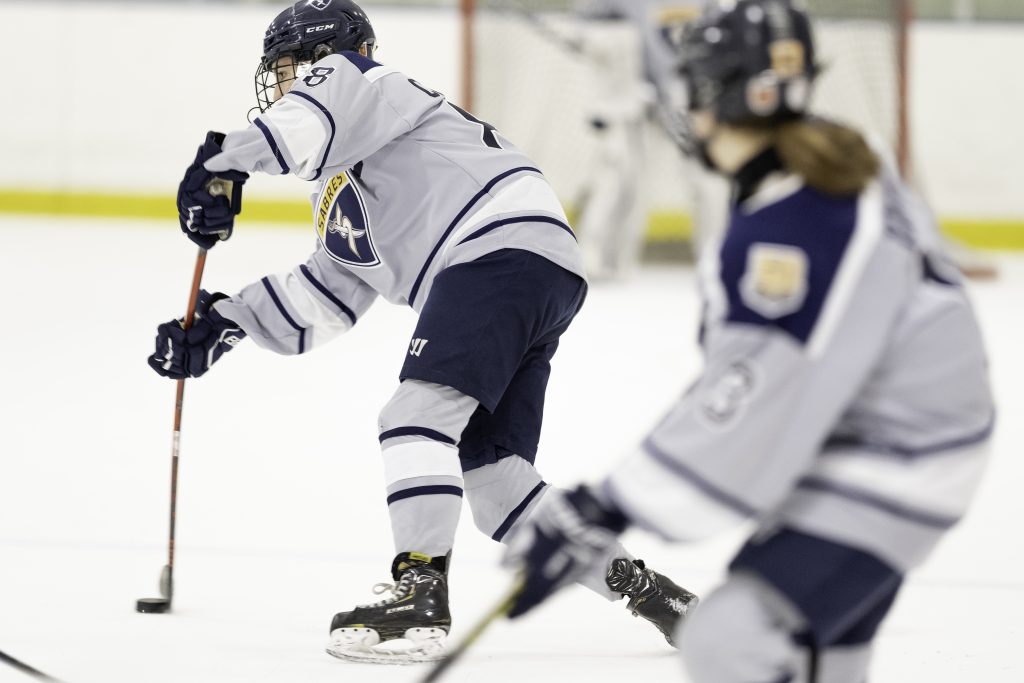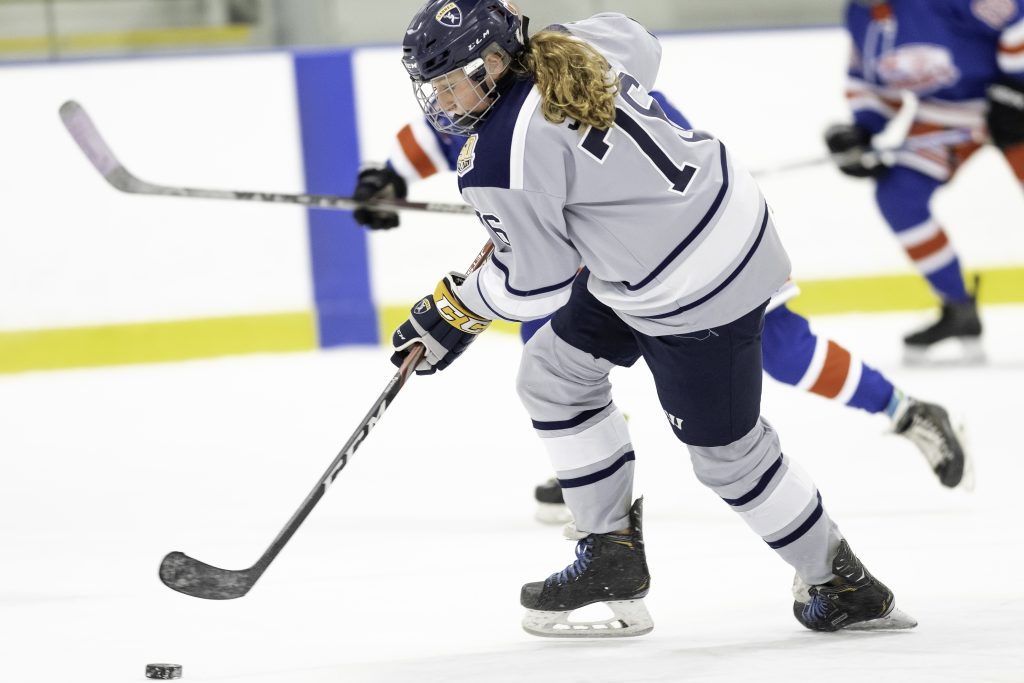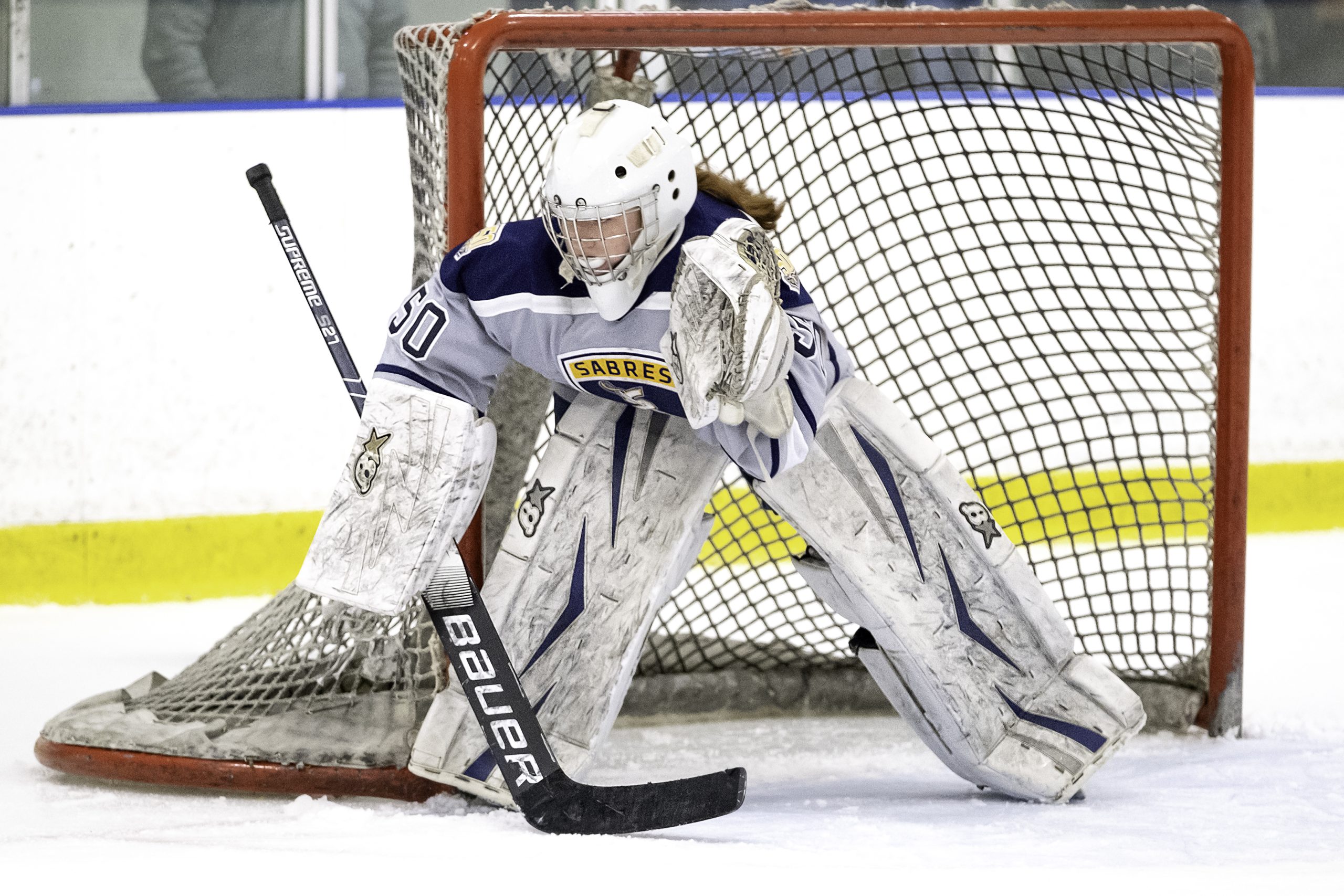Ice hockey imposes unique requirements on a camera lens due to the following: It is a fast-paced sport played indoors. The same can be said for similar sports like inline hockey, basketball, volleyball and indoor soccer. The size of a typical hockey arena and the ability to observe the game at close distances allows for a wide range of focal length options. However in order to consistently freeze hockey action (i.e. prevent motion blur), it helps to have camera gear built for sports. You can then pair that with specific photography techniques to make the most of that gear.
With this in mind, the first lenses you will want in your hockey photography arsenal should have the following properties:
| Property | Recommended Value | What it gives you |
|---|---|---|
| Max Aperture | f/2.8 | Allows fast shutter speeds and low ISO values |
| (Primary) Focal Length | 70-200mm for full-frame; 50-140mm for APS-C | Covers action from ice rink corner to first blue line |
| (Optional) Focal Length | 35-50mm for full-frame; 22-34mm for APS-C | For quick snaps when the action hits the glass |
| (Optional) Focal Length | 300mm for full-frame; 200mm for APS-C | Covers action on the other side of the rink |
Let us dive in further to explain the recommendations shown above, list specific camera lenses fitting those parameters, and add a few techniques to use them for hockey photography.
Maximum aperture of f2.8 supports fast shutter speeds to freeze action

In order to freeze action, we must setup our camera to use a fast shutter speed. For most hockey venues, this translates into shutter speed values no slower than 1/500th of a second. The challenge becomes the following: What aperture and ISO values should we use in conjunction with that shutter speed value in order to prevent photos from becoming too dark or noisy?
As a general rule to minimize noise in your photos, consider keeping your ISO settings lower than 6400. Some camera models are much better than others in keeping noise under control when setting ISO values over 6400. I used to shoot youth hockey with a Nikon D5 sometimes set at ISO 8000 in very dark venues without problems. Other modern cameras, like my Fuji X-T3 and X-T4 have, very good in-camera noise reduction and sharpening when setup to save images as JPEG.
To prevent your photos from becoming too dark, your last variable to consider is aperture. What aperture value should we use to achieve correct exposure when using a shutter speed of 1/500th and ISO 3200 indoors? It turns out to be somewhere between f/2.8 and f/4 in most youth hockey ice arenas. For example, in a well lit professional arena, f/4 will work well. However, in most local venues, you will find that f/2.8 is needed. Therefore, a lens supporting an aperture of f/2.8 is recommended for hockey. This is what some people may refer to as a “fast lens”. A fast lens allows optimal camera settings to freeze hockey action, achieve correct exposure and prevent image noise typically introduced with high ISO values.
Focal lengths of 70-200mm for full frame cameras (or equivalent 50-140mm for APS-C cameras) covers most of the action

A popular location to shoot an ice hockey game is near a rink corner. From this location, a 70-200mm lens allows you to cover from one end of the rink to the first blue line (almost half rink). This focal length range (70-200mm) also provides similar coverage for other indoor sports like basketball, indoor soccer and volleyball. Of course, each sport has its own nuances (I’ll highlight those in a future blog post). That makes 70-200mm a very popular and versatile focal length range for sports photography… so much that most major camera lens brands offer a f/2.8 version in that 70-200mm range.
Now, keep in mind that when I say “70-200mm”, I’m really referring to a focal length range for full (35mm) format camera gear. In order to determine the equivalent focal length on (for example) and APS-C camera, we need to divide that focal length value by what is referred to as a “crop factor”. The crop factor between a full frame camera and an APS-C camera is about 1.5 (or 1.6 depending on camera brand). This means that a full frame sensor is about 1.5 times larger than an APS-C sensor.
Therefore, my 50-120mm lens on my Fujifilm X-T3 (APS-C) camera provides a focal length equivalent to my 70-200mm lens on my Nikon D5 (full frame) camera.
Fast autofocus performance helps your camera track fast skaters

Your camera and lens work together in order to achieve fast autofocus. For best results, both elements must be designed with speed in mind. Results will vary greatly based on your camera specifications. In other words: Some cameras are very good at tracking fast moving objects, while others… not so much. I will write a separate post on cameras with fast autofocus. Fortunately, finding a fast length is a much easier task.
Most major camera gear vendors produce at least one fast 70-200mm (or equivalent) lens. For example, all the lenses listed at the end of this post are known for supporting very fast autofocus.
Lens vintage may also be a factor depending on your camera type. Some older fast 70-200mm lenses do not include internal motors. These provide great value for a lower price and weight, but require a strong camera capable of “working” that type of lens. For example, I loved to find older (but still brand new) Nikon fast lenses and use them on my Nikon D5. All of them provided excellent performance. As a side note: The Nikon D5 (and D6 for that matter) DSLR cameras still provide amazing performance today compared to many of the newer mirrorless products from Nikon, Canon, Sony, Fujifilm and Olympus (still available at the time of this writing).
On the other hand, most newer lenses in the “sports photography” category include multiple internal motors, which does not depend so much on the mechanical “prowess” of the camera. On my Fijufilm X-T3, I use my XF 50-140mm (70-200mm equivalent) very successfully. As a side note: Even though Fujifilm cameras may not be advertised as superstars when it comes to sports photography, I have been very successful in tailoring my X-T3 settings for fast paced sports, including ice hockey. Check out my set of blog posts on shooting sports with a Fuji X series camera.
Great primary hockey lenses from Canon, Nikon and Fujifilm
| Lens | Mount Type |
|---|---|
| Canon RF 70-200mm f/2.8L IS USM | Canon RF (R-series) |
| Canon EF 70-200mm f/2.8L IS III USM | Canon EF (DSRL) |
| Nikon Z 70-200mm f/2.8 VR S | Nikon Z FX (Z-series) |
| Nikon AF-S 70-200mm f/2.8E FL ED VR | Nikon FX (DSLR) |
| Sony FE 70-200mm f/2.8 G Master OSS | Sony E |
| Fujifilm XF 50-140mm | Fujifilm X |
